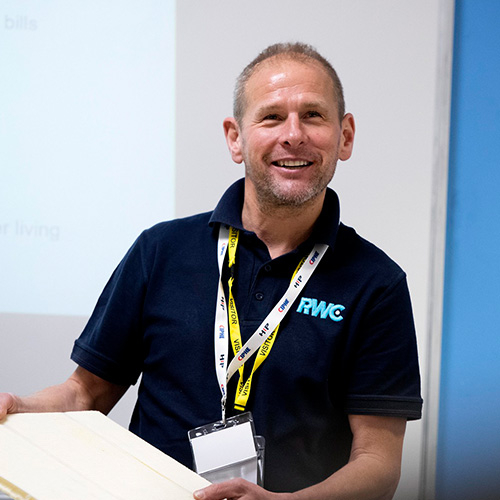Underfloor heating with ceramic tiles: a short guide

Underfloor heating (UFH) is one of the most efficient ways to heat a home. The system effectively turns the floor area of the home into a giant heat emitter, heating the rooms from the ground up. Due to the UK Government’s Build Back Better Plan, UFH systems are set to become much more commonplace, because they are more economical and compatible with ground and air source heat pumps, which are set to replace gas boilers.
Rising energy costs, incoming regulations from government, and overall changes in design trends set up the UFH industry to grow in the coming years, meaning that installers will benefit from being well versed in fitting various UFH systems.
There are many different finishes that can be used with a UFH system, however, because they transfer heat better than other floors, ceramic tiles are the most economical finish to your UFH system. So, here is our short guide to installing a perfect underfloor heating system with ceramic tiles.
Step 1 – Understanding your space
The first step when installing underfloor heating with ceramic tiles is making sure that you have a full understanding of the floor’s construction. New build homes typically have a solid concrete floor construction, followed by the insulation that the UFH pipework can be placed on top of before being screeded over and the finish laid.
There are several things to keep in mind during the planning stage, but crucially, installers must make sure that the insulation depth complies with regulations. This ensures that downward heat loss does not exceed 10 watts per m2 in accordance with BS EN 1264.

Step 2 – Planning your pipework
Once you understand the floor’s construction, you need to consider the space you are working with. This determines the pattern you will apply when laying the pipework.
A serpentine pattern is a simple up and down circuit pattern that is especially good for irregular shaped rooms such as kitchens with an island. Meanwhile, the counterflow pattern is a spiral-like design, which works well with square rooms. You can even combine the pipe layouts if required.
Regardless of the pattern, remember to plan your route to and from the manifold and out of the room to avoid any pipe layout mishaps.
Step 3 – Choosing your UFH fixing system
Once the underfloor heating with ceramic tiles has been planned out you must decide on the system to fix the pipework. There are three main systems to choose from for concrete floors.
First is the UFH staple system, where the pipe is stapled down to the insulation with a staple gun. This is the most cost-effective solution. However, the pipework must be marked and spaced properly; there should be a 200mm gap between the pipe circuits.
Next is the mounting rail system. A mounting rail is taped to the insulation and then fixed down with supplied pins, and the pipework is then slotted into the nodules of the rails. With this method, pipe circuits can be easily spaced by counting the nodules on the rail.
The third method is the floor panel system, where the guide provided by the floor panels creates a grid to ensure quick and easy laying of pipe. For each ‘egg box’ where the pipe sits in the panel, there is a gap of 50mm. This means the pipe can simply be clipped in.
Before installing, you must make sure that the insulation below the pipework is laid flat, and that the edge insulation is installed around the perimeter of the room. This ensures that once the screed is laid, it doesn’t crack as it expands.

Step 4 - Pressure testing, screeding, and tiling the ceramic tiles
After installing the pipework, a pressure test should be completed using water. Make sure that there are no traces of air in the system, as this can have a detrimental effect on how the system runs.
Best practice is to perform the following pressure test before any flooring or screed is laid:
- Raise the pressure to 2 bar for 10 minutes.
- Increase the pressure to 10 bar for another 10 minutes.
- Reduce the pressure back to 6 bar and leave it pressurised.
This allows for leaks to be detected and ensures the pipes reach maximum expansion. Maintain this pressure whilst the screed is laid and cured, which will prevent it from cracking later.
Step 5 - Slowly bring water temperature up after flooring installation
Once the screed is cured and the ceramic tiles are laid, installers should slowly build up the temperature in the underfloor heating pipework.
The initial water flow temperature should sit at 25ºC for three days. After three days, the temperature can be increased by 5ºC each day until the maximum design temperature is reached. This temperature is then maintained for another four days.
Right first time with RWC
Installing underfloor heating with ceramic tiles is straightforward and easy, however to those who are unprepared or lack the experience, the steps leading to a finished installation might appear daunting.
That’s why RWC is here to help. From our UFH pipe fixing systems through to our easy to work with pipe – JG Layflat – plus our push-fit manifolds and smart heating technology, you can get all the products you need from one single source.
With one of the largest technical teams in the UK, we are on hand to help at every turn. From complimentary CAD design and flow, temperature, and zoning advice, through to site visits, we can help ensure you get it right first time.
For more about RWC’s JG Underfloor, click here.
Need help choosing a system?
To choose the best underfloor heating system for your project, you will need to consider the floor construction installation requirements and the final floor finish.
